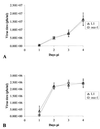Persistence of an occlusion-negative recombinant nucleopolyhedrovirus in Trichoplusia ni indicates high multiplicity of cellular infection
- PMID: 11679346
- PMCID: PMC93291
- DOI: 10.1128/AEM.67.11.5204-5209.2001
Persistence of an occlusion-negative recombinant nucleopolyhedrovirus in Trichoplusia ni indicates high multiplicity of cellular infection
Abstract
We use data from the serial passage of co-occluded recombinant Autographa californica nuclear polyhedrosis virus (AcMNPV) to estimate the viral multiplicity of infection of cells within infected insects. Co-occlusion, the incorporation of wild-type and mutant virus genomes in the same occlusion body, has been proposed as a strategy to deliver genetically modified viruses as insecticides in a way that contains their spread in the environment. It may also serve as a means whereby naturally occurring mutant forms of NPVs can be maintained in a stable polymorphism. Here, a recombinant strain of AcMNPV was constructed with a deletion of its polyhedrin gene, rendering it incapable of producing occlusion bodies (i.e., occlusion negative). This was co-occluded with wild-type AcMNPV and used to infect fifth-instar Trichoplusia ni larvae. The fate of both genotypes was monitored over several rounds of insect infection. Levels of the occlusion-negative virus genome declined slowly over successive rounds of infection. We applied these data to a model of NPV population genetics to derive an estimate of 4.3 +/- 0.3 viral genomes per occlusion body-producing cell.
Figures



Similar articles
-
Characterization of two Autographa californica nucleopolyhedrovirus proteins, Ac145 and Ac150, which affect oral infectivity in a host-dependent manner.J Virol. 2004 Jun;78(12):6439-48. doi: 10.1128/JVI.78.12.6439-6448.2004. J Virol. 2004. PMID: 15163737 Free PMC article.
-
Vertical transmission of TnSNPV, TnCPV, AcMNPV, and possibly recombinant NPV in Trichoplusia ni.J Invertebr Pathol. 2002 Jan;79(1):44-50. doi: 10.1016/S0022-2011(02)00003-4. J Invertebr Pathol. 2002. PMID: 12054786
-
Biological and molecular characterization of a multicapsid nucleopolyhedrovirus from Thysanoplusia orichalcea (L.) (Lepidoptera: Noctuidae).J Invertebr Pathol. 2005 Feb;88(2):126-35. doi: 10.1016/j.jip.2004.12.003. J Invertebr Pathol. 2005. PMID: 15766929
-
Baculovirus bounty.Science. 1995 Sep 29;269(5232):1834. doi: 10.1126/science.7569919. Science. 1995. PMID: 7569919 Review. No abstract available.
-
Nucleopolyhedrovirus Coocclusion Technology: A New Concept in the Development of Biological Insecticides.Front Microbiol. 2022 Jan 25;12:810026. doi: 10.3389/fmicb.2021.810026. eCollection 2021. Front Microbiol. 2022. PMID: 35145496 Free PMC article. Review.
Cited by
-
Coocclusion of Helicoverpa armigera Single Nucleopolyhedrovirus (HearSNPV) and Helicoverpa armigera Multiple Nucleopolyhedrovirus (HearMNPV): Pathogenicity and Stability in Homologous and Heterologous Hosts.Viruses. 2022 Mar 26;14(4):687. doi: 10.3390/v14040687. Viruses. 2022. PMID: 35458418 Free PMC article.
-
Functional importance of deletion mutant genotypes in an insect nucleopolyhedrovirus population.Appl Environ Microbiol. 2005 Aug;71(8):4254-62. doi: 10.1128/AEM.71.8.4254-4262.2005. Appl Environ Microbiol. 2005. PMID: 16085811 Free PMC article.
-
The multiplicity of infection of a plant virus varies during colonization of its eukaryotic host.J Virol. 2009 Aug;83(15):7487-94. doi: 10.1128/JVI.00636-09. Epub 2009 May 27. J Virol. 2009. PMID: 19474097 Free PMC article.
-
Intracellular bottlenecking permits no more than three tomato yellow leaf curl virus genomes to initiate replication in a single cell.PLoS Pathog. 2023 May 1;19(5):e1011365. doi: 10.1371/journal.ppat.1011365. eCollection 2023 May. PLoS Pathog. 2023. PMID: 37126519 Free PMC article.
-
Ultra Deep Sequencing of a Baculovirus Population Reveals Widespread Genomic Variations.Viruses. 2015 Jul 7;7(7):3625-46. doi: 10.3390/v7072788. Viruses. 2015. PMID: 26198241 Free PMC article.
References
-
- Ayres M D, Howard S C, Kuzio J, Lopez-Ferber M, Possee R D. The complete DNA sequence of Autographa californica nuclear polyhedrosis virus. Virology. 1994;202:586–605. - PubMed
-
- Beames B, Summers M D. Location and nucleotide sequence of the 25k protein missing from baculovirus few polyhedra (FP) mutants. Virology. 1989;168:344–353. - PubMed
-
- Bell R A, Owens C D, Shapiro M, Tardif J R. Mass rearing and virus production: development of mass-rearing technology. In: Doane C C, McManus M L, editors. The gypsy moth: research toward integrated pest management. U.S. Forest Service Technical Bulletin 1584. Washington, D.C.: U.S. Forest Service; 1981. pp. 599–655.
-
- Bishop D H L, Entwistle P F, Cameron I R, Allen C J, Possee R D. Field trials of genetically engineered baculovirus insecticides. In: Sussman M, Collins C H, Skinner F A, Stewart-Tull D E, editors. The release of genetically engineered microorganisms. London, England: Academic Press; 1988. pp. 143–179.
-
- Black B C, Brennan L A, Dierks P M, Gard I E. Commercialization of baculoviral insecticides. In: Miller L K, editor. The baculoviruses. New York, N.Y: Plenum Press; 1997. pp. 341–387.
Publication types
MeSH terms
LinkOut - more resources
Full Text Sources

